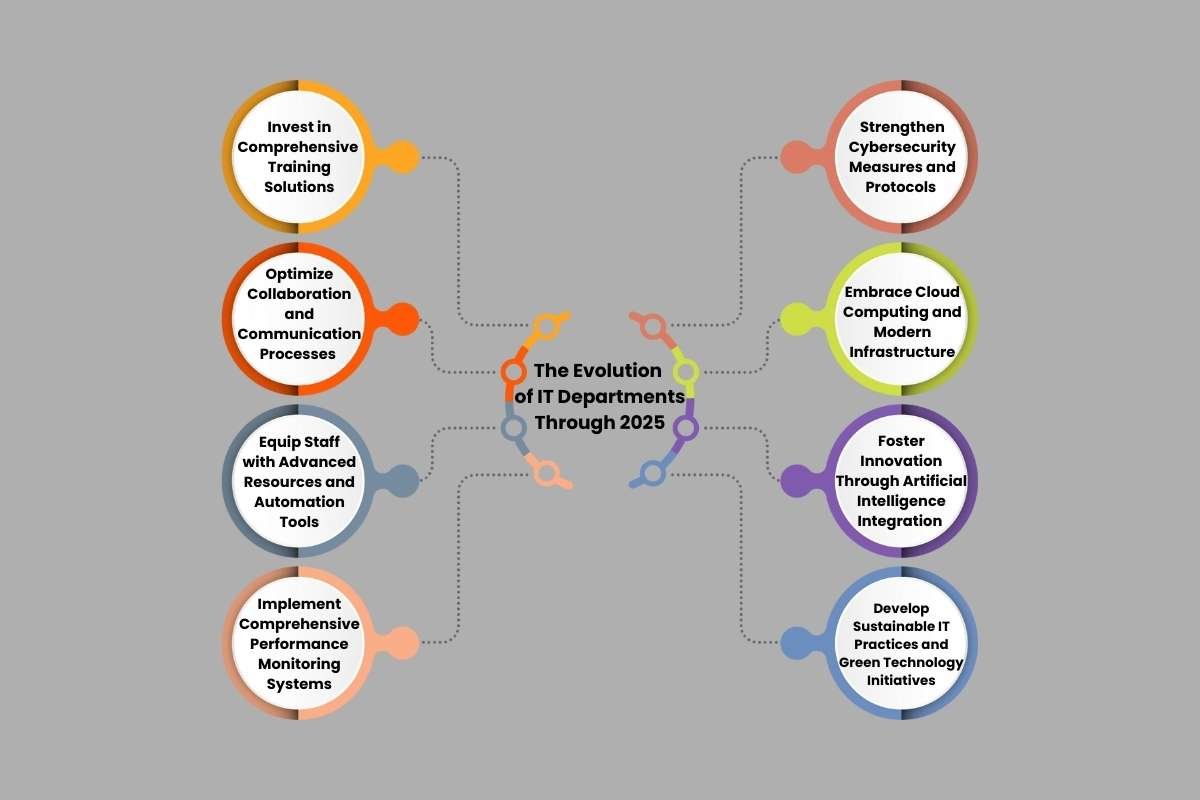Your business relies on multiple departments working together to achieve success, but few are as critical as your IT department. This internal team manages cybersecurity, maintains smooth virtual operations, and ensures your hardware, software, and connectivity systems work seamlessly to support daily business activities. In this digital workspace, the IT department has grown beyond simple tech support to become a strategic partner in business growth and innovation.
The intense technological advancements mean that IT departments face constant pressure to adapt and develop. From artificial intelligence integration to cloud migration, cybersecurity threats to remote work challenges, your IT team must stay ahead of emerging trends while maintaining reliable day-to-day operations. Companies that fail to invest in their IT departments often struggle with outdated systems, security vulnerabilities, and inefficient processes that hinder overall business performance.
To build strength, businesses must plan strategically, allocate resources wisely, and train employees consistently. The goal is simple: to improve the IT department, so it solves problems while also driving innovation. A well-functioning IT team becomes a real advantage, improving the organization’s decision-making, customer experience, and efficiency.
The Evolution of IT Departments Through 2025

Over the past decade, IT departments have transformed from cost centers handling maintenance to strategic enablers of business growth. Technology is now central to operations, making IT a key driver of innovation. By 2025, IT teams will work closely with other departments to align solutions with business goals, fueled by cloud adoption, artificial intelligence, and data-driven decision-making.
The COVID-19 pandemic accelerated this shift, forcing rapid adoption of cloud platforms, secure remote access, and scalable systems to support distributed workforces. This highlighted the need for flexible, adaptable IT operations.
Looking ahead, IT departments will continue growing as strategic partners, playing critical roles in digital transformation, cybersecurity, AI integration, and sustainability. The most effective departments will balance operational reliability with innovation, ensuring their organizations remain competitive in a fast-changing digital world.
1. Invest in Comprehensive Training Solutions
Training is one of the most effective ways to improve the IT department and ensure your team stays current. Technology evolves quickly, so modern programs must cover emerging skills, like AI, cloud systems, and security, and essential basics. Flexible formats, such as workshops, online certifications, and virtual sessions, allow staff to apply their knowledge directly to their work.
The benefits go beyond updated skills. Well-trained employees are more confident, stay longer, and handle change with less stress. Training also attracts ambitious talent who value growth opportunities. Teams with the right skills introduce new technologies faster, reducing mistakes and boosting efficiency.
To make training work, conduct regular skill assessments to identify gaps. Targeting resources prevents waste and ensures staff learn what matters most. With consistent training, your IT department stays ready for new challenges instead of falling behind.
2. Optimize Collaboration and Communication Processes
Clear communication and collaboration are vital for smooth IT operations. Without them, projects face delays, resources are misused, and misunderstandings pile up. Modern collaboration platforms combine messaging, video, and project tracking, reducing the need for multiple tools and keeping work in one place.
Project frameworks like Agile or Scrum bring structure with daily check-ins, defined roles, and feedback cycles. These methods help teams stay aligned, resolve issues faster, and deliver consistent results. Regular stand-ups are especially effective in spotting obstacles early.
Strong collaboration must also extend outside IT. Regular updates with other departments ensure projects connect to real business goals. When IT teams understand broader company objectives, they design solutions that add direct value. Improving these processes strengthens productivity and makes the IT department a trusted partner.
3. Equip Staff with Advanced Resources and Automation Tools
Providing efficient tools is critical to improving the IT department. Outdated systems drain time, frustrate staff, and slow delivery. Modern solutions, especially automation tools, handle repetitive tasks such as system monitoring, updates, and backups. Automating these reduces errors and frees staff for more strategic work.
Cloud-based platforms offer flexibility and scalability, making them a strong choice for growing organizations. Tools that integrate with existing systems and include reporting features give teams better control and visibility. Analytics also help identify weak areas and measure impact.
Choosing the right tools begins with reviewing workflows. Pinpoint bottlenecks and focus resources where they solve the most problems. This ensures upgrades improve productivity without unnecessary costs. When IT teams work with up-to-date systems and automation, they deliver faster results and maintain reliable operations.
4. Implement Comprehensive Performance Monitoring Systems

Performance monitoring provides the insights needed to improve the IT department effectively. It involves tracking both technical and business metrics. Technical data such as uptime, response speed, or incident resolution shows efficiency. Business metrics like cost savings, project delivery, and user satisfaction reveal broader impact.
Balanced monitoring connects IT’s work directly to company performance. Reviews should include individual progress and team outcomes, offering professional growth and process improvement opportunities. Regular benchmarking against industry standards also helps highlight where the department stands compared to competitors.
Effective systems rely on a mix of complex data and stakeholder feedback. Hearing from both employees and business units provides context behind the numbers. This approach ensures IT efforts match company needs while keeping improvement goals realistic and measurable. Monitoring is about tracking, proving value, and driving progress.
5. Strengthen Cybersecurity Measures and Protocols
In 2025, cybersecurity is one of the most critical areas to focus on when working to improve the IT department. Threats are more advanced and frequent, requiring stronger, prevention-focused strategies. Zero-trust frameworks, frequent security assessments, and AI-based detection tools now form the backbone of modern defense.
Employee awareness remains equally important. Many incidents stem from human error, so regular training helps staff recognize risks such as phishing or weak credentials. Interactive sessions are updated frequently to keep employees engaged and informed.
Preparedness is also essential. A well-defined incident response plan minimizes downtime and damage when a breach occurs. These plans should be tested often and adjusted based on real events. By combining prevention, education, and readiness, organizations strengthen defenses while building confidence across teams and stakeholders.
6. Embrace Cloud Computing and Modern Infrastructure
Cloud adoption is no longer optional; improving the IT department and maintaining competitiveness is necessary. Cloud systems reduce hardware costs, provide scalable storage, support remote work, and enhance disaster recovery. For many, hybrid approaches balance on-premises needs with cloud flexibility.
Shifting to the cloud also frees IT staff from routine maintenance, allowing them to focus on strategic projects. This shift improves morale and positions the team as a driver of innovation.
Success depends on planning. Businesses should assess which systems suit migration, develop staged timelines, and ensure minimal disruption. Continuous monitoring of cloud usage also prevents overspending, as resources can be resized and optimized regularly. With thoughtful adoption and cost control, cloud computing delivers efficiency, resilience, and long-term value.
7. Foster Innovation Through Artificial Intelligence Integration
Artificial intelligence has become a powerful way to improve the IT department by boosting efficiency and foresight. AIOps, or AI for IT operations, uses real-time data to predict issues, identify risks, and even resolve problems before they impact users. This reduces downtime and improves service quality.
AI also strengthens cybersecurity by detecting unusual activity patterns that traditional tools might miss. Intelligent monitoring gives IT teams a stronger defense as attacks grow more complex.
Implementation should start small. Pilots in areas like automated monitoring or help desk chatbots let teams learn gradually. Once successful, expansion into broader functions is easier. With careful rollout, AI transforms IT from reactive support into a proactive problem solver.
8. Develop Sustainable IT Practices and Green Technology Initiatives
Sustainability now plays a significant role in IT strategy. To improve the IT department, organizations are adopting greener technologies that cut energy costs and reduce environmental impact. Energy-efficient servers, innovative cooling systems, and renewable-powered data centers are becoming standard.
Cloud platforms also contribute to efficiency by sharing resources across many users, reducing overall consumption. Device lifecycle management ensures equipment is used entirely and responsibly recycled.
Software optimization and energy-conscious design add further benefits. Choosing tools with lower power demands reduces costs while supporting corporate sustainability goals. These efforts build goodwill with customers and employees alike.
By prioritizing sustainable practices, IT departments contribute not only to business performance but also to long-term responsibility. This forward-looking approach enhances efficiency and strengthens organizational reputation.
Measuring Success and Continuous Improvement

Precise measurement is vital to improve the IT department systematically. Practical assessment blends technical data, such as uptime and incident resolution, with business-focused outcomes like user satisfaction and project delivery. This ensures IT’s role is visible across the organization.
Regular reviews at both individual and team levels highlight strengths and reveal gaps. Benchmarking against industry standards provides context, showing where the department outperforms or lags behind peers.
Continuous improvement should be part of everyday culture. Encourage staff to suggest enhancements, revisit procedures, and monitor industry best practices. Stakeholder feedback also ensures IT priorities remain aligned with company goals.
By building an environment of measurement and refinement, organizations create IT teams that adapt quickly and remain valuable contributors to business success.
The Future of IT Departments: Looking Beyond 2025

The IT department of the future will be a strategic partner rather than a support unit. Organizations will need to embrace advanced technologies like quantum computing, edge processing, and next-generation AI to improve the IT department. These innovations will redefine speed, security, and efficiency.
The skills IT professionals require are also expanding. Technical expertise remains vital, but business understanding, leadership, and change management are becoming just as important. Departments that invest in broader development will be well placed to lead transformation.
Sustainability and resilience will remain core priorities. Companies will expect IT to deliver efficient, secure, and environmentally conscious solutions. By continuing to evolve in these areas, IT departments will become drivers of growth and competitive advantage well into the future.
Conclusion
To improve the IT department, focus on training, modern tools, performance monitoring, security, cloud adoption, AI, and sustainability. These strategies build efficiency, resilience, and innovation. Improvement is continuous, not one-time. With consistent effort and collaboration, your IT department becomes a trusted partner, driving faster decisions, better operations, and long-term business success.


















